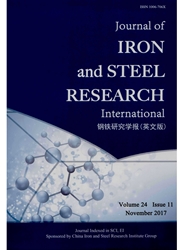

 中文摘要:
中文摘要:
在高铬的钒钛磁铁矿的凝块的 MgO 流动的优化使用通过泉华和小团实验系统地被调查。MgO 在菱镁矿形式被增加。当在泉华的 MgO 的内容从 1.95wt% 被增加到 2.63wt% 时,低温度的减小降级索引从 80.57% ~ 82.71% 增加了。当在小团的 MgO 的内容从 1.14wt% 被增加到 2.40wt% 时,减小胀大的索引从 15.2% ~ 8.6% 减少了;然而,氧化小团的压缩力量戏剧性地减少了,它是有 1.14wt% 的一个 MgO 内容的 1985 N。这压缩力量不为强风炉子生产满足要求。当所有上述的结果被考虑时,有与一个低 MgO 内容匹配小团的高 MgO 内容 2.63wt% 的泉华不到 1.14wt% 是为在强风炉子熔炼高铬的钒钛磁铁矿的合理负担结构。
 英文摘要:
英文摘要:
The optimized use of MgO flux in the agglomeration of high-chromium vanadium-titanium magnetite was investigated system- atically through sinter and pellet experiments. MgO was added in the form of magnesite. When the content of MgO in the sinter was in- creased from 1.95wt% to 2.63wt%, the low-temperature reduction degradation index increased from 80.57% to 82.71%. When the content of MgO in the pellet was increased from 1.14wt% to 2.40wt%, the reduction swelling index decreased from 15.2% to 8.6%; however, the com- pressive strength of the oxidized pellet decreased dramatically and it was 1985 N with an MgO content of 1.14wt%. This compressive strength does not satisfy the requirements for blast-furnace production. When all of the aforementioned results were taken into account, the sinter with a high MgO content (2.63wt%) matching the pellet with a low MgO content (less than 1.14wt%) was the rational burden structure for smelting high-chromium vanadium-titanium magnetite in blast furnaces.
 同期刊论文项目
同期刊论文项目
 同项目期刊论文
同项目期刊论文
 Preliminary study on photocatalytic degradation of methyl orange and Cr(VI) compound system by titan
Preliminary study on photocatalytic degradation of methyl orange and Cr(VI) compound system by titan Photocatalytic oxidation of methyl orange over titania-bearing blast furnace slag photocatalysts and
Photocatalytic oxidation of methyl orange over titania-bearing blast furnace slag photocatalysts and Preparation of UV-visible light responsive photocatalyst from titania-bearing blastfurnace slag modi
Preparation of UV-visible light responsive photocatalyst from titania-bearing blastfurnace slag modi Preparation and characterization of Zn/Ce/SO42--doped titania nano-materials with antibacterial acti
Preparation and characterization of Zn/Ce/SO42--doped titania nano-materials with antibacterial acti Preparation and Characterization of Zinc and Cerium Co-doped Titania Nano-materials with Antibacteri
Preparation and Characterization of Zinc and Cerium Co-doped Titania Nano-materials with Antibacteri A new process of gas-based direct reduction electric furnace smelting separation for high chromium v
A new process of gas-based direct reduction electric furnace smelting separation for high chromium v Preparation and characterization of carbon or/and boron-doped titania nano-materials with antibacter
Preparation and characterization of carbon or/and boron-doped titania nano-materials with antibacter 期刊信息
期刊信息
